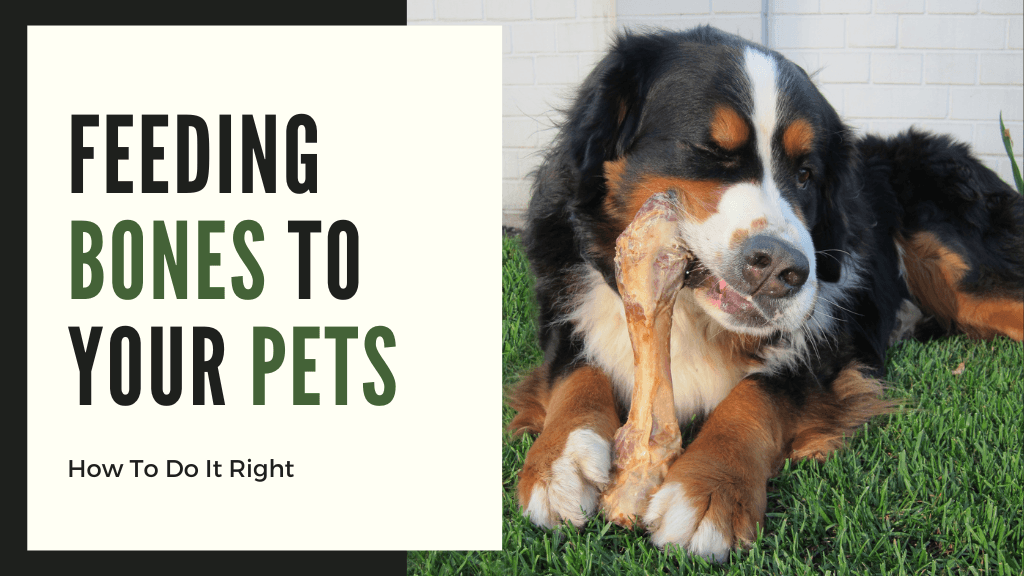Feeding Bones to Your Pets - How To Do It Right
)
The connection between dogs and bones is a familiar one, yet it's crucial to approach bone feeding with caution. While the idea of dogs and bones often go hand in paw, it's important to only give a dog a bone under certain circumstances. Our aim is to equip you with the knowledge to make informed decisions that prioritise your pet's safety and well-being.
In this blog, we'll debunk misconceptions, discuss the benefits of bone feeding, and share essential tips for safe practices. Our focus is on providing you with insights that empower you to make thoughtful choices for your furry companion. Let's dive into the details that matter most:
Myth 1: All Bones Are Safe for Pets
Reality: This is a common misconception. Not all bones are safe for pets to consume. Cooked bones, in particular, are brittle and can splinter, leading to serious internal injuries. They can easily break into sharp shards that can do a lot of damage when they pass through the gastrointestinal tract. Never feed your dog cooked bones. This includes those that originate in your kitchen and those that can be purchased.
Myth 2: Raw Bones Are Always Safe
Reality: While raw bones are generally safer than cooked bones, they still carry risks. Size, type, and the individual pet's chewing habits play a significant role in determining safety. Aim to pick a bone that is approximately the size of your dog’s head. Choosing bones that are the right size for your dog lets them enjoy chewing while lowering the risk of them breaking off and swallowing a piece that could lead to health issues.
Myth 3: Bones Are an Essential Part of a Pet's Diet
Reality: While bones can offer certain nutritional benefits, they are not essential. A balanced diet that meets your pet's nutritional needs should always be the priority.
Benefits of Feeding Bones to Pets
Dental Health: Chewing on raw bones helps scrape away plaque, contributing to better oral health and fresher breath.
Mental Stimulation: Bones offer mental stimulation, particularly for pets with strong chewing instincts, reducing boredom and destructive behaviour.
Nutritional Content: Bones contain minerals like calcium and phosphorus, crucial for bone health. Remember, bones should enhance a balanced diet, not substitute it.
Addressing Potential Risks
Feeding bones has its rewards, but risks also accompany this practice. Watch out for choking hazards, splintering bones (especially cooked ones), digestive issues during introduction, and potential dental problems from excessively hard bones.
Frequency Matters
Moderation is key. Aim to offer bones once or twice a week, letting your pet chew for 15-20 minutes then removing. This approach balances dental benefits and prevents overconsumption.
Precautions for Safe Bone Consumption
Always supervise your pet while chewing to prevent choking and avoid cooked bones. Choose raw, meaty bones suitable for your pet's size and breed.
Balanced Diet and Bone Consumption
Bones complement nutrition but shouldn't replace a balanced diet. Chat with our team to strike the right balance and ensure your pet's happiness and health.
Observing Your Pet's Reaction
Observe your pet's reaction after bone consumption. Watch for signs of discomfort, vomiting, or digestive issues. If your pet shows any negative reactions, discontinue bone feeding and consult our team. It's essential to be attentive to their behaviour to ensure bones are a safe and suitable addition to their diet.

Signs of Trouble
Be vigilant for potential issues after your pet consumes bones. Signs of discomfort, vomiting, diarrhoea, or excessive drooling could indicate a problem. Also, observe for any difficulty in passing stools or signs of choking. If you notice these symptoms, call us at the clinic promptly. Your pet's safety and well-being are paramount, and addressing any concerning signs early can prevent complications.
What About Cats?
Feeding bones to cats requires even more caution due to their unique dietary needs and smaller size. Unlike dogs, cats are carnivores, with their diets primarily consisting of meat. While some raw meaty bones can be offered to cats, it's important to note that cats may not be as accustomed to chewing bones as dogs are. Additionally, bones should always be appropriately sized and suitable for a cat's smaller frame. Supervision is crucial to prevent choking or ingestion of bone fragments.
Consult Our Expert Team
Before introducing bones to your pet's diet, you might like to consult our knowledgeable team. We offer tailored advice based on your pet's unique needs, ensuring their safety and well-being.
Feeding bones to your pets can be both beneficial and potentially risky. Our goal is to guide you through the complexities, enabling you to make informed decisions that prioritise your pet's health and happiness. With the right approach, you can offer bones safely, enriching your pet's life while keeping them healthy and content. Remember, your pet's well-being is our top priority, and we're here to support you every step of the way.
| Tags:DogClient InformationHealth AdviceProactive Pet Care |
&geometry(126x115))